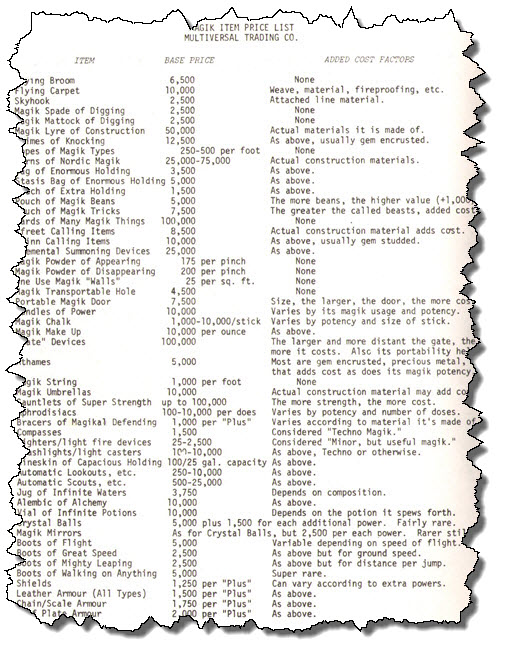Welcome To Skull Tower, Part VI
Welcome To Skull Tower, Part VI
Usury & Unicorns
Well, There’s No Actual Unicorns. But Not Many Words Start With ‘U’.
Usury & Ukeleles? Usury & Umbrellas? Usury & Unicycles?
I Give Up
Welcome to “Welcome To Skull Tower, Part VI”. In what is rapidly becoming a ritual, I note this will be a relatively short excursion, as I spent yesterday working on some actual paid gaming work, leaving me only a few hours before I need to leave to go play in my weekly Pathfinder game, and there’s no time during the week to write. So it goes.We continue our shopping spree, as we have many pages of price lists to go. By the way, you may have heard that in Ye Olde Schoole Dayse, magic items were as rare as merciful game masters, and there were no “magic item shops” or the like, and people weren’t decked out like Christmas trees covered in magic items, and if you played every week for three years, you might, just might, have found a rusty +1 dagger, and you cherished it like it was your own child, and blah blah blah.
Hope that clears that up.
There’s a lot of stuff to buy in Arduin, ranging from the mundane (a pound of salt for 1 silver penny) to the… not so mundane (Orichalcum golem, base price 100,000 gs, but you’ll want to add in extras like haste (15,000) and magik defense (also 15,000). But, you ask, “How can I afford these wonderful things when every orc I kill only has 1d4 copper pieces on it?” Well, that’s easy.
You take out a loan.
Now, it doesn’t specify what the loan term is or how often it’s compounded, but that 50% has got to be nasty at first level… and, by the way…
Yeah. Miss a payment, wake up dead.
It is noted that just because there’s a price list, doesn’t mean the item is actually for sale… the Multiversal Trading Company has to buy something before it can sell it, after all. This serves as a way for the GM to prevent some items from entering his campaign — after all, only they know what has been “bought” in the past. For example, it may be the case that no cheese is in stock at the moment, or what is in stock is extremely runny.
Of course, most players don’t want salt, or golems, or salt golems, they want weapons.
As you can see, you can pretty much cost out most any combination you wish. A few points:
- In Arduin, weapons can have different “plusses” for to-hit and damage. Do you buy them twice (so +1 to hit, +1 to damage is 2 plusses?) or does this chart assume the more traditional rule that a +1 weapon is +1 to both?
- The prices really don’t make a lot of sense, even by the standards of the day. Why, for example, is adding life draining to a two-handed hammer (750) so much cheaper than adding it to a scimitar? I even checked the weapon vs. AC and weapon damage vs. monster size tables in The Arduin Grimoire. The two-handed hammer is a better weapon on both counts. Yeah, you can’t use a shield, but do the math. For the cost of adding life draining to a scimitar (5000), you can it to a 2-handed hammer (750) and make it a +4 weapon! I have to assume there was some internal logic behind a chart this detailed, but damned if I can figure it out.
- Likewise, some of these prices should just be flat rates… is a dagger that speaks Dwarvish somehow less useful than a sling that speaks Dwarvish? (Hell, for 145 gold/language, a dagger could be a lot cheaper than a translator, and easier to carry, too. Broadswords are cheaper still, but harder to bring with you to a social gathering.)
Man (Dwarf, Kobbit, Phraint, Centaur…) Cannot Live Kill By Magic Weapons Alone
Having a +5 Two Handed Hammer of Life Drain is nice, but as we’ve seen from earlier articles, Arduin is not a safe place. You need more if you want to make it to 100th level as an Outlaw and get a +1 with any missile weapon! Fortunately, Dave Hargrave has you covered.
So hear you go. This is, to be sure, hardly an exhaustive list of magic items (we’re also not done with this section), but it does have a lot of the most common.
- “Horns Of Nordic Magik”… I guess Dave worried “Horn of Valhalla” might bring down TSR’s lawyers? Ditto “Cards Of Many Magik Things” and “Gauntlets of Super Strength”.
- No “Added Cost Factors” for magic brooms? Sheesh, in the Harry Potter books, there’s an entire industry centered around them.
- “Variable depending on speed of flight” is nice, but… varies how? +x GP/10′ of base flight speed? What? Ah well. A lot of what’s cool about Arduin, as I said before, is that it consists much more of “nudges to get you thinking” than it does “absolute rules”. The books in general… and much of the area I’m exploring now, in particular… are more “stuff to think about you may not have thought to think about” (think about it — that does parse correctly) than truly definitive lists.
- I am not sure what “Magik String” does.
- It’s sort of amusing that “Boots of Walking On Anything” are “Super Rare”, but the “Deck of Many Magik Things”, which is well-known as a TPK engine, isn’t. Or, perhaps, that’s the point. “Hey, you guys want to spend 100 grand to screw yourselves over in a dozen horrific ways? Be my guest.” The boots, OTOH, are likely to be very useful in foiling the GMs most cunning plans. (I utterly pissed off my GM when, in my Pathfinder game, I pointed out that Water Walking, despite its name, also let us walk harmlessly on top of molten lava… said so right in the spell description… we were able to enter a major fight having taken far less damage than he’d expected. Heh heh heh. Some things never change.)
As I said, this has to be brief… next time… golems, rings, scrolls, one of the few remaining Erol Otus drawings, and “Old Oliphant Puke”.





The frigging HELL there weren’t magic (magik?) shops back in the day; I seem to recall I had one in at least one of the Towns in my campaign. I mean, there’s a GP sale price listed for magic items/weapons in the DMG; who the hell did people think was buying those goodies? Other PCs? PUH-LEESE.